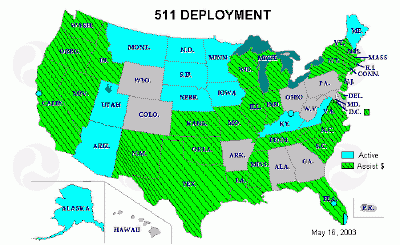1.Please briefly explain the 511 system with respect to understanding
a caller's location. How does it work currently? What information
is provided to the traveler?
Current and planned 511 systems do not know callers' locations.
Calls are routed by phone companies to the proper 511 system based on a
caller's telephone access point, but that access point information is not
passed to the 511 system. When first connected, callers request information
for whatever region and/or road they wish. They may even opt to be
switched to another 511 system in another region if they plan to drive
out of their current region and want to know traffic conditions within
their destination region. Users select the information they want
from voice menus by spoken commands and/or touch-tone key commands.
They generally have choices of information about transit, traffic, severe
weather alerts, general weather conditions, weather-related travel delays
, planned roadwork, planned events, etc. If they choose traffic,
then they have choices of regions (e.g., East Bay) and/or roads (e.g.,
I-880). They then receive voice descriptions of the traffic conditions
(crashes, congestion, roadwork, etc.) on I-880. The 511 Alliance
can provide a fully automatic Interactive Voice Response system that provides
traffic information using concatenated speech and/or text to speech.
2.511 is a telephone-based system. Can you explain what basic
services will be offered to state and local agencies through this 511 Alliance
of companies? With each company offering a basic component (traffic,
digital data, weather, and project management), it appears that the alliance
is
offering to build a Traffic Management center for public safety
departments. True?
The 511 Alliance can provide a remotely hosted service for a DOT using
existing Westwood One traffic information that requires no DOT Traffic
Management Center (TMC) nor any traffic information content from that DOT.
Or, if the DOT has a TMC and its own content, the 511 Alliance can incorporate
the DOT's content either into a 511 Alliance system installed in the TMC
or into a remotely-hosted, 511 Alliance system at some other location.
In either case, the DOT's information can be supplemented and enhanced
with existing Westwood One information and by Westwood One operators.
In addition the DOT will receive statewide weather-alerting capabilities,
as well as weather-related travel delays from Meteorlogix. As with
traffic, if the DOT has an existing RWIS (road weather information system)
in place, Meteorlogix can incorporate that data into the weather information
they provide. This is extremely important to rural ITS, where there
is generally little traffic information available.
Our goal is to meet the DOT customers' specific requirements on a very rapid schedule by making maximum use of existing 511 Alliance products and services. The modular nature of the 511 Alliance's products and services allows us to quickly tailor a system and service that meets the customers' requirements with state-of-the-art features and content and at low cost for the value received.
3.Is this alliance of companies a precursor to offering wireless
location services to travelers (or how does it work currently with cellular
calls)? Is there a graphical or geographical representation of the
traveler information sent to cell phones or is the information in text
form only?
Currently, 511 information is delivered primarily as voice telephony.
While location-based services could be provided by 511 systems in the future,
that is not a currently planned feature. Cell phone geolocation services
are not yet widely available in the U.S.and will initially be deployed
to meet the E911 FCC mandate. E911 and 511 will be entirely separate
and independent services.
4.This alliance targets local governments but is there an intention
by the participating companies to provide service directly to consumers
or through cellular telecommunication carriers?
From a business perspective, DOTs are the only realistic customers
for 511 systems and services. Attempts to cover the costs of traveler
information telephone systems with consumer fees or with advertising or
sponsorships have failed in the past, and we do not see that changing in
the future. That's not to say that some revenues cannot be generated,
but we never expect those revenues to cover the costs of the systems.
The DOTs must pay the majority of the costs if they want sustainable 511
systems. There already are traveler information services available
through some wireless carriers. We expect those services to be complementary
to 511 services in the future by offering premium personalized services
included as part of cellular subscribers regular monthly fees. The
511 Alliance is going after DOT customers, not wireless carriers.
5.What is the long-range vision of the 511 Alliance? What
services or products will be offered?
The 511 Alliance was formed to provide near-term, quick-response, feature-rich
511 solutions for DOTs that want to deploy new 511 systems and for DOTs
that want to replace outmoded existing systems. The Alliance offerings
will evolve with new technologies and with new customer requirements possibly
to include automated location-based traveler information, route-specific
travel times, active weather alerting based on the location of the traveler,
and other information content. But at the moment we are focusing
on meeting today's needs of today's customers. The National 511 Deployment
Coalition has established clear near-term implementation guidelines for
511 systems which most systems in operation today have yet to meet.
The 511 Alliance's mix of available content, proven ability to integrate
government-supplied and private content, and off-the-shelf telephone systems
allows us to meet the guidelines in any part of the country from the start.
6.What business catalysts must be present in order for the market
for direct traveler information to become a viable consumer service?
Continuous government funding to acquire and to operate 511 systems
is essential to make 511 a viable consumer service. As intimated
in 4.above, we don't anticipate that such systems will ever be commercially
self-supported by consumers, advertising, or any similar business model.
